University Report: Atmospheric Pollution from Local to Global Scales
VerifiedAdded on 2022/08/15
|7
|1742
|12
Report
AI Summary
This report examines atmospheric pollution from local to global scales, focusing on ozone depletion and climate change. It begins by detailing the chemical reactions involved in ozone formation and the role of NOx and other compounds. The report then analyzes latitudinal and seasonal variations in ozone changes, including the effects of tropospheric weather systems and greenhouse gas emissions. It further discusses how increased tropospheric water due to global warming reduces global tropospheric ozone, emphasizing the role of water vapor, CFCs, and other pollutants. Finally, the report projects the future impact of climate change on atmospheric chemistry and ozone levels, considering the effects of human activities, pollution, and changes in weather patterns, and the role of policy changes and technological advancements. The report references key studies and provides a comprehensive overview of the complex interactions affecting the ozone layer and the atmosphere.
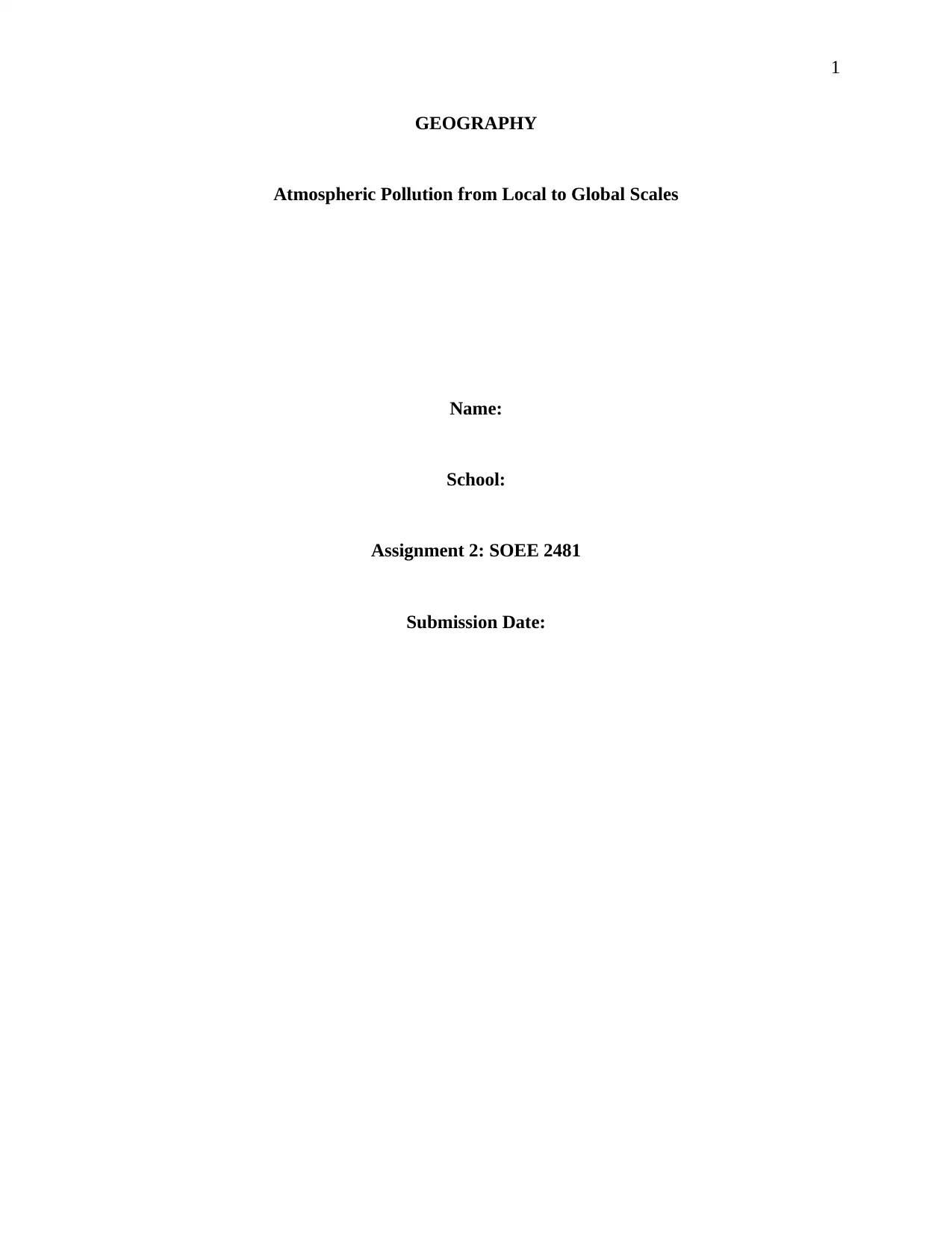
1
GEOGRAPHY
Atmospheric Pollution from Local to Global Scales
Name:
School:
Assignment 2: SOEE 2481
Submission Date:
GEOGRAPHY
Atmospheric Pollution from Local to Global Scales
Name:
School:
Assignment 2: SOEE 2481
Submission Date:
Paraphrase This Document
Need a fresh take? Get an instant paraphrase of this document with our AI Paraphraser
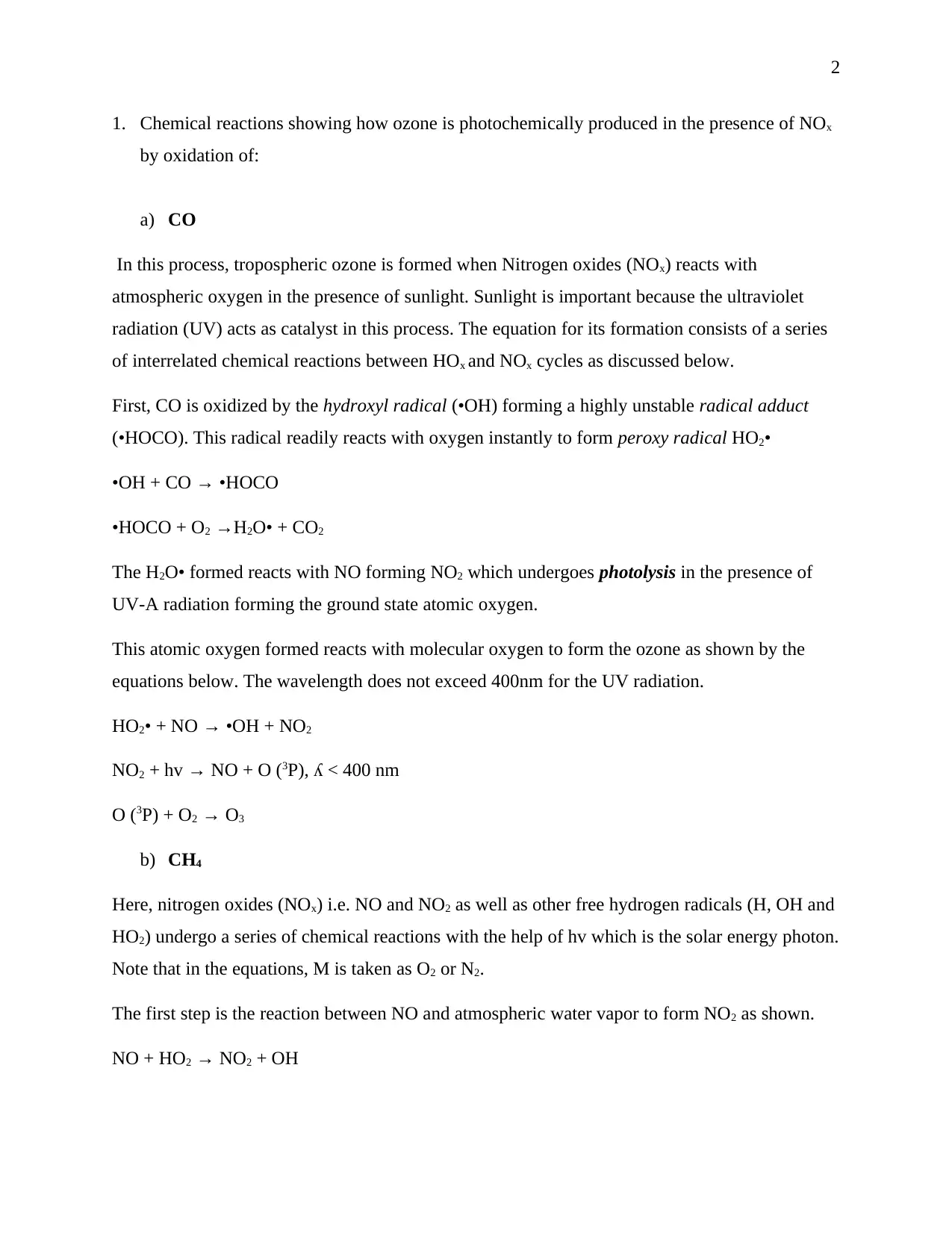
2
1. Chemical reactions showing how ozone is photochemically produced in the presence of NOx
by oxidation of:
a) CO
In this process, tropospheric ozone is formed when Nitrogen oxides (NOx) reacts with
atmospheric oxygen in the presence of sunlight. Sunlight is important because the ultraviolet
radiation (UV) acts as catalyst in this process. The equation for its formation consists of a series
of interrelated chemical reactions between HOx and NOx cycles as discussed below.
First, CO is oxidized by the hydroxyl radical (•OH) forming a highly unstable radical adduct
(•HOCO). This radical readily reacts with oxygen instantly to form peroxy radical HO2•
•OH + CO → •HOCO
•HOCO + O2 →H2O• + CO2
The H2O• formed reacts with NO forming NO2 which undergoes photolysis in the presence of
UV-A radiation forming the ground state atomic oxygen.
This atomic oxygen formed reacts with molecular oxygen to form the ozone as shown by the
equations below. The wavelength does not exceed 400nm for the UV radiation.
HO2• + NO → •OH + NO2
NO2 + hv → NO + O (3P), ʎ < 400 nm
O (3P) + O2 → O3
b) CH4
Here, nitrogen oxides (NOx) i.e. NO and NO2 as well as other free hydrogen radicals (H, OH and
HO2) undergo a series of chemical reactions with the help of hv which is the solar energy photon.
Note that in the equations, M is taken as O2 or N2.
The first step is the reaction between NO and atmospheric water vapor to form NO2 as shown.
NO + HO2 → NO2 + OH
1. Chemical reactions showing how ozone is photochemically produced in the presence of NOx
by oxidation of:
a) CO
In this process, tropospheric ozone is formed when Nitrogen oxides (NOx) reacts with
atmospheric oxygen in the presence of sunlight. Sunlight is important because the ultraviolet
radiation (UV) acts as catalyst in this process. The equation for its formation consists of a series
of interrelated chemical reactions between HOx and NOx cycles as discussed below.
First, CO is oxidized by the hydroxyl radical (•OH) forming a highly unstable radical adduct
(•HOCO). This radical readily reacts with oxygen instantly to form peroxy radical HO2•
•OH + CO → •HOCO
•HOCO + O2 →H2O• + CO2
The H2O• formed reacts with NO forming NO2 which undergoes photolysis in the presence of
UV-A radiation forming the ground state atomic oxygen.
This atomic oxygen formed reacts with molecular oxygen to form the ozone as shown by the
equations below. The wavelength does not exceed 400nm for the UV radiation.
HO2• + NO → •OH + NO2
NO2 + hv → NO + O (3P), ʎ < 400 nm
O (3P) + O2 → O3
b) CH4
Here, nitrogen oxides (NOx) i.e. NO and NO2 as well as other free hydrogen radicals (H, OH and
HO2) undergo a series of chemical reactions with the help of hv which is the solar energy photon.
Note that in the equations, M is taken as O2 or N2.
The first step is the reaction between NO and atmospheric water vapor to form NO2 as shown.
NO + HO2 → NO2 + OH
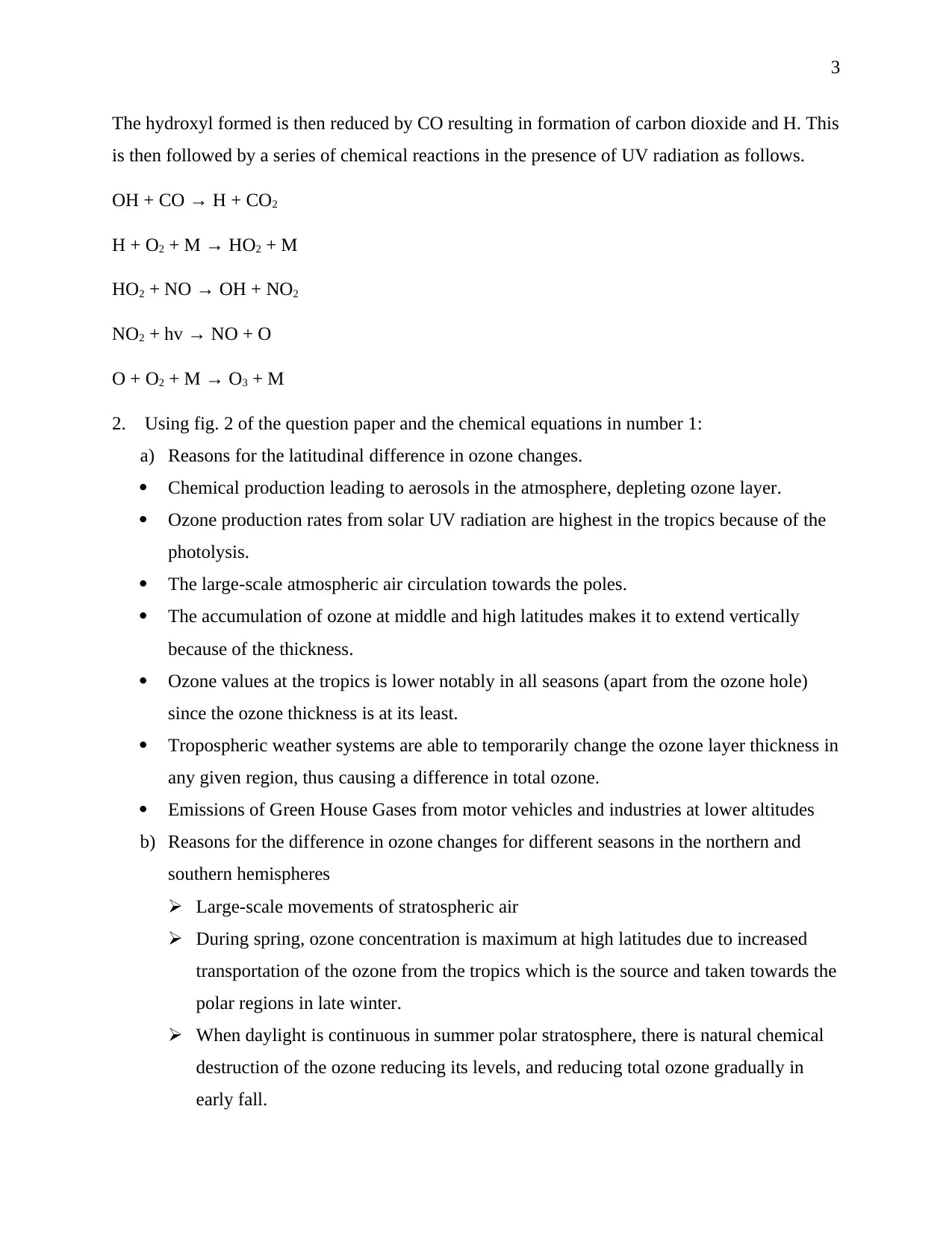
3
The hydroxyl formed is then reduced by CO resulting in formation of carbon dioxide and H. This
is then followed by a series of chemical reactions in the presence of UV radiation as follows.
OH + CO → H + CO2
H + O2 + M → HO2 + M
HO2 + NO → OH + NO2
NO2 + hv → NO + O
O + O2 + M → O3 + M
2. Using fig. 2 of the question paper and the chemical equations in number 1:
a) Reasons for the latitudinal difference in ozone changes.
Chemical production leading to aerosols in the atmosphere, depleting ozone layer.
Ozone production rates from solar UV radiation are highest in the tropics because of the
photolysis.
The large-scale atmospheric air circulation towards the poles.
The accumulation of ozone at middle and high latitudes makes it to extend vertically
because of the thickness.
Ozone values at the tropics is lower notably in all seasons (apart from the ozone hole)
since the ozone thickness is at its least.
Tropospheric weather systems are able to temporarily change the ozone layer thickness in
any given region, thus causing a difference in total ozone.
Emissions of Green House Gases from motor vehicles and industries at lower altitudes
b) Reasons for the difference in ozone changes for different seasons in the northern and
southern hemispheres
Large-scale movements of stratospheric air
During spring, ozone concentration is maximum at high latitudes due to increased
transportation of the ozone from the tropics which is the source and taken towards the
polar regions in late winter.
When daylight is continuous in summer polar stratosphere, there is natural chemical
destruction of the ozone reducing its levels, and reducing total ozone gradually in
early fall.
The hydroxyl formed is then reduced by CO resulting in formation of carbon dioxide and H. This
is then followed by a series of chemical reactions in the presence of UV radiation as follows.
OH + CO → H + CO2
H + O2 + M → HO2 + M
HO2 + NO → OH + NO2
NO2 + hv → NO + O
O + O2 + M → O3 + M
2. Using fig. 2 of the question paper and the chemical equations in number 1:
a) Reasons for the latitudinal difference in ozone changes.
Chemical production leading to aerosols in the atmosphere, depleting ozone layer.
Ozone production rates from solar UV radiation are highest in the tropics because of the
photolysis.
The large-scale atmospheric air circulation towards the poles.
The accumulation of ozone at middle and high latitudes makes it to extend vertically
because of the thickness.
Ozone values at the tropics is lower notably in all seasons (apart from the ozone hole)
since the ozone thickness is at its least.
Tropospheric weather systems are able to temporarily change the ozone layer thickness in
any given region, thus causing a difference in total ozone.
Emissions of Green House Gases from motor vehicles and industries at lower altitudes
b) Reasons for the difference in ozone changes for different seasons in the northern and
southern hemispheres
Large-scale movements of stratospheric air
During spring, ozone concentration is maximum at high latitudes due to increased
transportation of the ozone from the tropics which is the source and taken towards the
polar regions in late winter.
When daylight is continuous in summer polar stratosphere, there is natural chemical
destruction of the ozone reducing its levels, and reducing total ozone gradually in
early fall.
⊘ This is a preview!⊘
Do you want full access?
Subscribe today to unlock all pages.

Trusted by 1+ million students worldwide
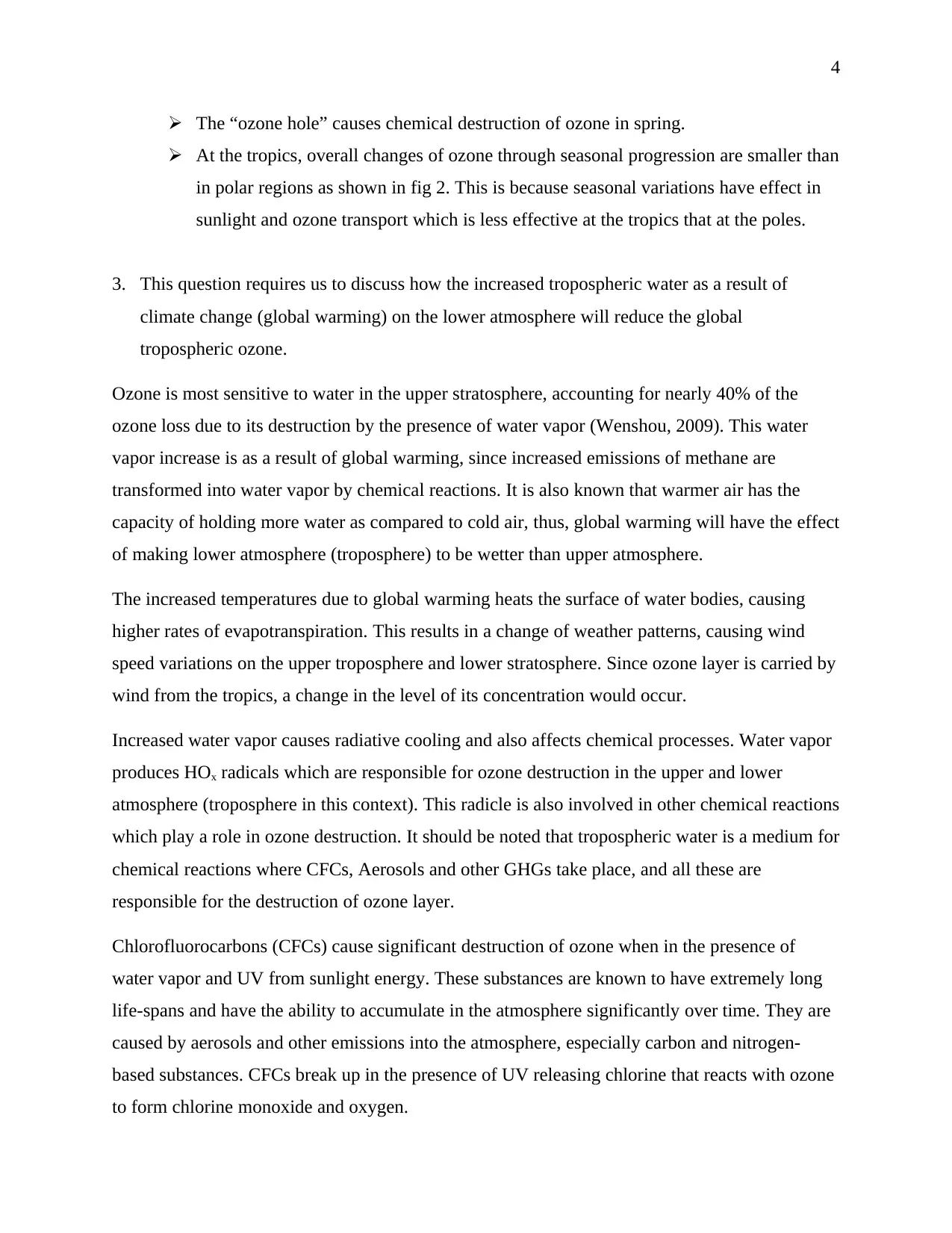
4
The “ozone hole” causes chemical destruction of ozone in spring.
At the tropics, overall changes of ozone through seasonal progression are smaller than
in polar regions as shown in fig 2. This is because seasonal variations have effect in
sunlight and ozone transport which is less effective at the tropics that at the poles.
3. This question requires us to discuss how the increased tropospheric water as a result of
climate change (global warming) on the lower atmosphere will reduce the global
tropospheric ozone.
Ozone is most sensitive to water in the upper stratosphere, accounting for nearly 40% of the
ozone loss due to its destruction by the presence of water vapor (Wenshou, 2009). This water
vapor increase is as a result of global warming, since increased emissions of methane are
transformed into water vapor by chemical reactions. It is also known that warmer air has the
capacity of holding more water as compared to cold air, thus, global warming will have the effect
of making lower atmosphere (troposphere) to be wetter than upper atmosphere.
The increased temperatures due to global warming heats the surface of water bodies, causing
higher rates of evapotranspiration. This results in a change of weather patterns, causing wind
speed variations on the upper troposphere and lower stratosphere. Since ozone layer is carried by
wind from the tropics, a change in the level of its concentration would occur.
Increased water vapor causes radiative cooling and also affects chemical processes. Water vapor
produces HOx radicals which are responsible for ozone destruction in the upper and lower
atmosphere (troposphere in this context). This radicle is also involved in other chemical reactions
which play a role in ozone destruction. It should be noted that tropospheric water is a medium for
chemical reactions where CFCs, Aerosols and other GHGs take place, and all these are
responsible for the destruction of ozone layer.
Chlorofluorocarbons (CFCs) cause significant destruction of ozone when in the presence of
water vapor and UV from sunlight energy. These substances are known to have extremely long
life-spans and have the ability to accumulate in the atmosphere significantly over time. They are
caused by aerosols and other emissions into the atmosphere, especially carbon and nitrogen-
based substances. CFCs break up in the presence of UV releasing chlorine that reacts with ozone
to form chlorine monoxide and oxygen.
The “ozone hole” causes chemical destruction of ozone in spring.
At the tropics, overall changes of ozone through seasonal progression are smaller than
in polar regions as shown in fig 2. This is because seasonal variations have effect in
sunlight and ozone transport which is less effective at the tropics that at the poles.
3. This question requires us to discuss how the increased tropospheric water as a result of
climate change (global warming) on the lower atmosphere will reduce the global
tropospheric ozone.
Ozone is most sensitive to water in the upper stratosphere, accounting for nearly 40% of the
ozone loss due to its destruction by the presence of water vapor (Wenshou, 2009). This water
vapor increase is as a result of global warming, since increased emissions of methane are
transformed into water vapor by chemical reactions. It is also known that warmer air has the
capacity of holding more water as compared to cold air, thus, global warming will have the effect
of making lower atmosphere (troposphere) to be wetter than upper atmosphere.
The increased temperatures due to global warming heats the surface of water bodies, causing
higher rates of evapotranspiration. This results in a change of weather patterns, causing wind
speed variations on the upper troposphere and lower stratosphere. Since ozone layer is carried by
wind from the tropics, a change in the level of its concentration would occur.
Increased water vapor causes radiative cooling and also affects chemical processes. Water vapor
produces HOx radicals which are responsible for ozone destruction in the upper and lower
atmosphere (troposphere in this context). This radicle is also involved in other chemical reactions
which play a role in ozone destruction. It should be noted that tropospheric water is a medium for
chemical reactions where CFCs, Aerosols and other GHGs take place, and all these are
responsible for the destruction of ozone layer.
Chlorofluorocarbons (CFCs) cause significant destruction of ozone when in the presence of
water vapor and UV from sunlight energy. These substances are known to have extremely long
life-spans and have the ability to accumulate in the atmosphere significantly over time. They are
caused by aerosols and other emissions into the atmosphere, especially carbon and nitrogen-
based substances. CFCs break up in the presence of UV releasing chlorine that reacts with ozone
to form chlorine monoxide and oxygen.
Paraphrase This Document
Need a fresh take? Get an instant paraphrase of this document with our AI Paraphraser
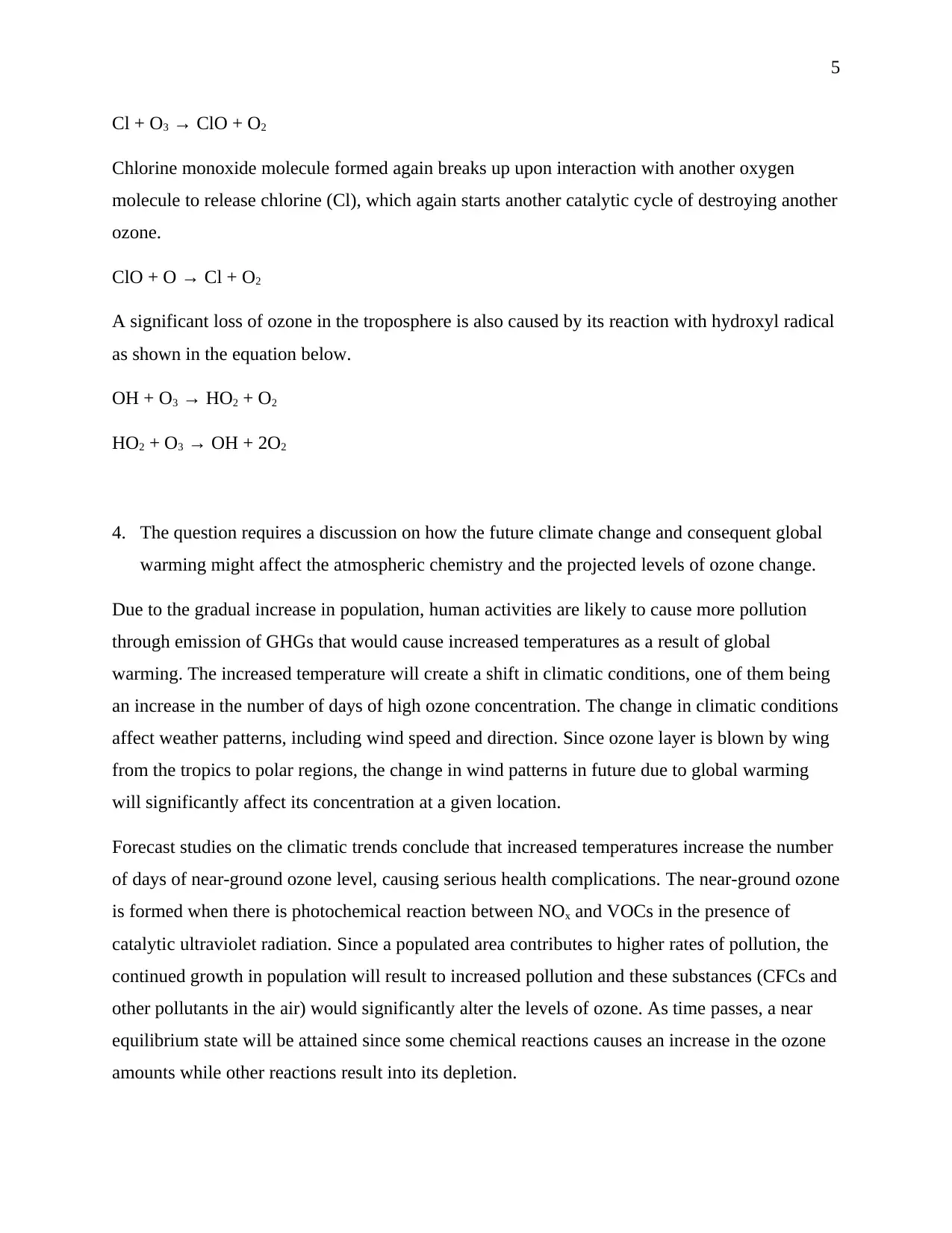
5
Cl + O3 → ClO + O2
Chlorine monoxide molecule formed again breaks up upon interaction with another oxygen
molecule to release chlorine (Cl), which again starts another catalytic cycle of destroying another
ozone.
ClO + O → Cl + O2
A significant loss of ozone in the troposphere is also caused by its reaction with hydroxyl radical
as shown in the equation below.
OH + O3 → HO2 + O2
HO2 + O3 → OH + 2O2
4. The question requires a discussion on how the future climate change and consequent global
warming might affect the atmospheric chemistry and the projected levels of ozone change.
Due to the gradual increase in population, human activities are likely to cause more pollution
through emission of GHGs that would cause increased temperatures as a result of global
warming. The increased temperature will create a shift in climatic conditions, one of them being
an increase in the number of days of high ozone concentration. The change in climatic conditions
affect weather patterns, including wind speed and direction. Since ozone layer is blown by wing
from the tropics to polar regions, the change in wind patterns in future due to global warming
will significantly affect its concentration at a given location.
Forecast studies on the climatic trends conclude that increased temperatures increase the number
of days of near-ground ozone level, causing serious health complications. The near-ground ozone
is formed when there is photochemical reaction between NOx and VOCs in the presence of
catalytic ultraviolet radiation. Since a populated area contributes to higher rates of pollution, the
continued growth in population will result to increased pollution and these substances (CFCs and
other pollutants in the air) would significantly alter the levels of ozone. As time passes, a near
equilibrium state will be attained since some chemical reactions causes an increase in the ozone
amounts while other reactions result into its depletion.
Cl + O3 → ClO + O2
Chlorine monoxide molecule formed again breaks up upon interaction with another oxygen
molecule to release chlorine (Cl), which again starts another catalytic cycle of destroying another
ozone.
ClO + O → Cl + O2
A significant loss of ozone in the troposphere is also caused by its reaction with hydroxyl radical
as shown in the equation below.
OH + O3 → HO2 + O2
HO2 + O3 → OH + 2O2
4. The question requires a discussion on how the future climate change and consequent global
warming might affect the atmospheric chemistry and the projected levels of ozone change.
Due to the gradual increase in population, human activities are likely to cause more pollution
through emission of GHGs that would cause increased temperatures as a result of global
warming. The increased temperature will create a shift in climatic conditions, one of them being
an increase in the number of days of high ozone concentration. The change in climatic conditions
affect weather patterns, including wind speed and direction. Since ozone layer is blown by wing
from the tropics to polar regions, the change in wind patterns in future due to global warming
will significantly affect its concentration at a given location.
Forecast studies on the climatic trends conclude that increased temperatures increase the number
of days of near-ground ozone level, causing serious health complications. The near-ground ozone
is formed when there is photochemical reaction between NOx and VOCs in the presence of
catalytic ultraviolet radiation. Since a populated area contributes to higher rates of pollution, the
continued growth in population will result to increased pollution and these substances (CFCs and
other pollutants in the air) would significantly alter the levels of ozone. As time passes, a near
equilibrium state will be attained since some chemical reactions causes an increase in the ozone
amounts while other reactions result into its depletion.
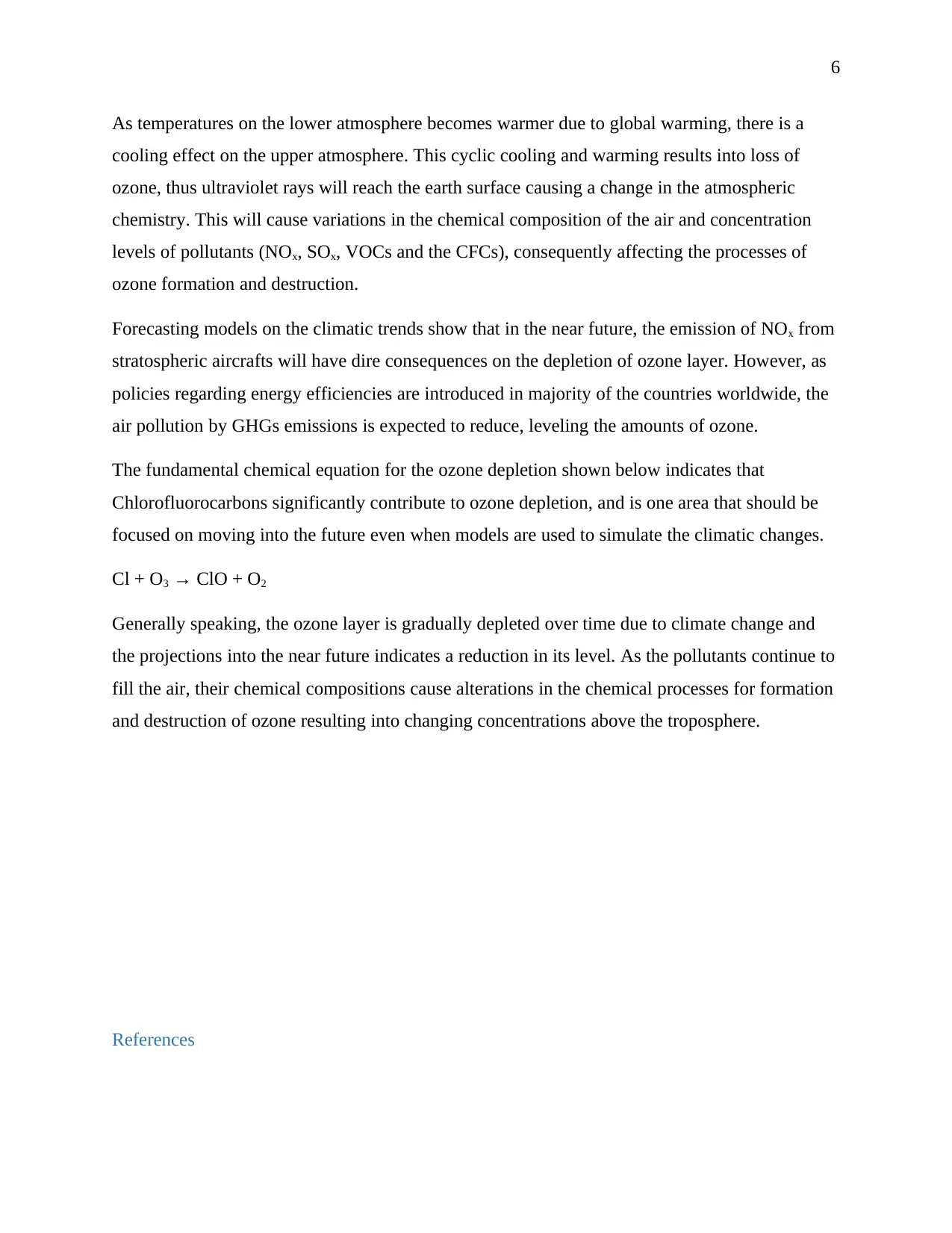
6
As temperatures on the lower atmosphere becomes warmer due to global warming, there is a
cooling effect on the upper atmosphere. This cyclic cooling and warming results into loss of
ozone, thus ultraviolet rays will reach the earth surface causing a change in the atmospheric
chemistry. This will cause variations in the chemical composition of the air and concentration
levels of pollutants (NOx, SOx, VOCs and the CFCs), consequently affecting the processes of
ozone formation and destruction.
Forecasting models on the climatic trends show that in the near future, the emission of NOx from
stratospheric aircrafts will have dire consequences on the depletion of ozone layer. However, as
policies regarding energy efficiencies are introduced in majority of the countries worldwide, the
air pollution by GHGs emissions is expected to reduce, leveling the amounts of ozone.
The fundamental chemical equation for the ozone depletion shown below indicates that
Chlorofluorocarbons significantly contribute to ozone depletion, and is one area that should be
focused on moving into the future even when models are used to simulate the climatic changes.
Cl + O3 → ClO + O2
Generally speaking, the ozone layer is gradually depleted over time due to climate change and
the projections into the near future indicates a reduction in its level. As the pollutants continue to
fill the air, their chemical compositions cause alterations in the chemical processes for formation
and destruction of ozone resulting into changing concentrations above the troposphere.
References
As temperatures on the lower atmosphere becomes warmer due to global warming, there is a
cooling effect on the upper atmosphere. This cyclic cooling and warming results into loss of
ozone, thus ultraviolet rays will reach the earth surface causing a change in the atmospheric
chemistry. This will cause variations in the chemical composition of the air and concentration
levels of pollutants (NOx, SOx, VOCs and the CFCs), consequently affecting the processes of
ozone formation and destruction.
Forecasting models on the climatic trends show that in the near future, the emission of NOx from
stratospheric aircrafts will have dire consequences on the depletion of ozone layer. However, as
policies regarding energy efficiencies are introduced in majority of the countries worldwide, the
air pollution by GHGs emissions is expected to reduce, leveling the amounts of ozone.
The fundamental chemical equation for the ozone depletion shown below indicates that
Chlorofluorocarbons significantly contribute to ozone depletion, and is one area that should be
focused on moving into the future even when models are used to simulate the climatic changes.
Cl + O3 → ClO + O2
Generally speaking, the ozone layer is gradually depleted over time due to climate change and
the projections into the near future indicates a reduction in its level. As the pollutants continue to
fill the air, their chemical compositions cause alterations in the chemical processes for formation
and destruction of ozone resulting into changing concentrations above the troposphere.
References
⊘ This is a preview!⊘
Do you want full access?
Subscribe today to unlock all pages.

Trusted by 1+ million students worldwide
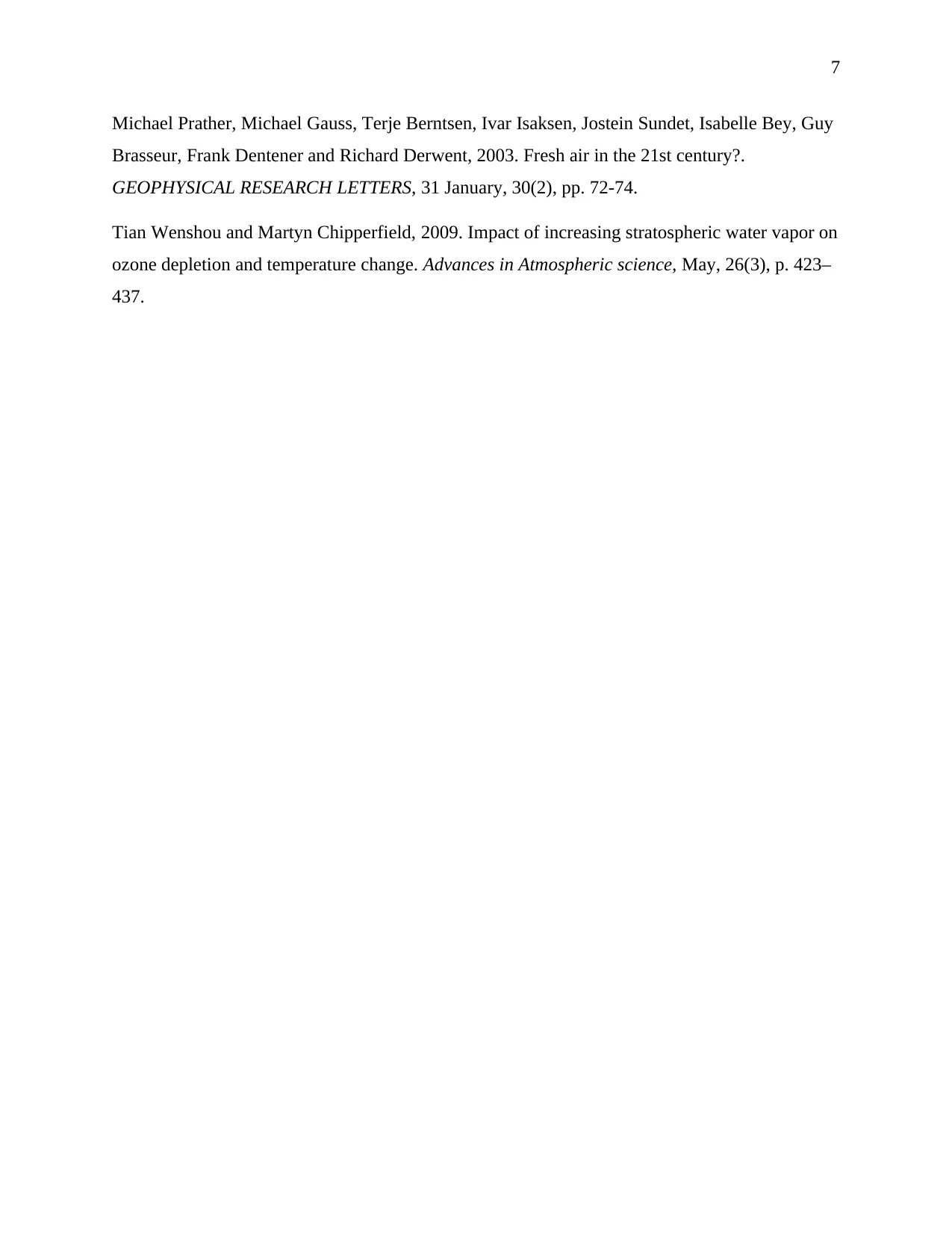
7
Michael Prather, Michael Gauss, Terje Berntsen, Ivar Isaksen, Jostein Sundet, Isabelle Bey, Guy
Brasseur, Frank Dentener and Richard Derwent, 2003. Fresh air in the 21st century?.
GEOPHYSICAL RESEARCH LETTERS, 31 January, 30(2), pp. 72-74.
Tian Wenshou and Martyn Chipperfield, 2009. Impact of increasing stratospheric water vapor on
ozone depletion and temperature change. Advances in Atmospheric science, May, 26(3), p. 423–
437.
Michael Prather, Michael Gauss, Terje Berntsen, Ivar Isaksen, Jostein Sundet, Isabelle Bey, Guy
Brasseur, Frank Dentener and Richard Derwent, 2003. Fresh air in the 21st century?.
GEOPHYSICAL RESEARCH LETTERS, 31 January, 30(2), pp. 72-74.
Tian Wenshou and Martyn Chipperfield, 2009. Impact of increasing stratospheric water vapor on
ozone depletion and temperature change. Advances in Atmospheric science, May, 26(3), p. 423–
437.
1 out of 7
Your All-in-One AI-Powered Toolkit for Academic Success.
+13062052269
info@desklib.com
Available 24*7 on WhatsApp / Email
![[object Object]](/_next/static/media/star-bottom.7253800d.svg)
Unlock your academic potential
Copyright © 2020–2025 A2Z Services. All Rights Reserved. Developed and managed by ZUCOL.
